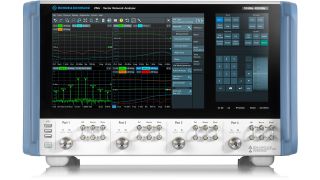

Load pull analysis solutions
Nonlinear device characterization for active components
Active devices, such as power amplifiers (PA), are not inherently 50 Ohm components. They are designed to operate in an environment where the characteristic impedance is nominally 50 Ohms, but in reality, the impedance can vary widely. In other words, while the environment they are meant to operate in is typically standardized to 50 Ohms, the actual impedance seen by the amplifier can deviate from this value.
In order to achieve specific target specifications, such as minimizing power consumption or optimizing modulation performance, it is crucial to optimize the matching of components with the surrounding environment. This requires a test environment with variable impedances, as the performance of active devices can vary significantly depending on the impedances they are interfaced with in the target design. Load pull analysis is key to determining the optimal operating conditions, or “sweet spot,” for the final design.
In wireless systems, amplifiers often drive the RF signal into an antenna for transmission. These antennas show severe variance in their impedance around the nominal 50 Ohms. This varying impedance, seen by the amplifier, has unpredictable effects on amplifier performance and capabilities. It affects gain and efficiency, as well as modulation performance such as error vector magnitude (EVM).
Rohde & Schwarz is working with leading load pull companies to offer complete turnkey solutions for passive, active and hybrid load pull systems. Measurements can be conducted traditionally or via probing systems, depending on the accessibility of the device under test (DUT).
Your load pull testing challenges
Load pull measurements are applied in various test scenarios, and each comes with its own challenges. The scenarios can be divided into two categories: design optimization and modeling.
Design optimization challenges:
- Understanding the characteristics of different key performance indicators (KPI) across different impedances: The performance is typically shown in contour plots across a Smith chart for different impedances. Scenarios include continuous wave‑based (CW‑based) and modulated test cases based on the active device target usage. This information allows various target figures, such as maximum output power, lowest intermodulation, adjacent channel leakage ratio (ACLR) and EVM or best energy efficiency, to be optimized. Unfortunately, different KPIs have different sweet spots, so trade-offs must often be made when optimizing for the target application.
- Impedance optimization at second and third harmonic frequencies: Both impedance tuning at the fundamental frequency and impedance optimization at the second and third harmonic frequencies are required for best efficiency. This is especially true for higher power applications.
- Designing matching networks for PA transistors: This requires knowledge of the inherent device impedance at the input and output. Source pull at the input and load pull on the output help to identify the correct values.
- Verifying system level performance with different impedances at the RF frontend: This is done with a load pull measurement setup and often includes modulated performance verification with load pull testing. At the system level, when the radio frequency (RF) PA is connected to an antenna for wireless communication covering multiple frequency bands, the PA needs to handle the impedance variation of the antenna over the total used frequency range.
In modeling, the main challenge is creating reliable PA transistor models, as used in system-level simulation. For this, the transistors’ behavior must be described across many working conditions (e.g., frequency and level range), device settings (e.g., biasing) and different impedances on the input and output. Load pull analysis is typically used to get this information.
High-performance solutions for load pull testing
Load pull relies on the flexible variation of the impedance presented to the DUT, such as an RF power amplifier. This can be applied to the output as load pull or to the input as source pull, and the techniques remain the same. Load pull can be categorized based on approach and application:
- Passive load pull
- Active load pull
- Hybrid load pull
- Harmonic load pull
- Wideband modulated load pull


Passive load pull is the traditional approach that uses mechanical impedance tuners on the input for source pull and/or output for load pull. It is placed between the DUT and the test instrumentation. For the tuners, we work with our solution partners Focus Microwaves and Maury Microwave. For the main test instrument, we recommend the flexible vector network analyzer R&S®ZNA with direct receiver access.


Active load pull involves active impedance tuning. Mismatched impedances create forward and reverse signal waves. It is possible to actively create and inject the reverse signal to create a certain impedance. In addition, replacing the tuner by injecting a synthesized reverse signal with the appropriate level and phase allows a wider tuning range by removing mechanical tuner losses.


Hybrid load pull involves hybrid tuning, which offers the benefits of both passive and active load pull. Passive tuning is used for pre-matching and handling high levels, while active signal injection is used to speed up the tuning and enlarge the available tuning range.


Harmonic load pull allows impedances to be controlled not only at the fundamental frequency but also at harmonic frequencies. The purpose is to optimize the transistor efficiency.


Wideband modulated load pull addresses modulation performance verification with different impedances, mostly focusing on the output impedance. It is typically used to verify the power amplifier performance when connected to an antenna. The RF frontend and antenna is typically used over a wider frequency range and multiple transmission bands, such as in 5G or Wi-Fi.
Active load pull is the preferred method, as passive tuners show a too large frequency response for wider modulation bandwidths. The setup requires accurate timing and high phase accuracy between the input signal RF1 and the tuning signal RF2. Additionally, the measurement of the forward and reverse waves a1, a2 and b1, b2 must be in absolute phase and time synchronization, which can be achieved using an RF oscilloscope. The dual-channel vector signal generator R&S®SMW200A and the oscilloscope R&S®RTP are perfectly suited to this task. Impedance control can be done with the ScopeSuite automation oscilloscope software .
Benefits of our load pull testing solutions
The Rohde & Schwarz load pull measurement setup allows all parameter values of interest to be derived from the measured wave quantities. The user can also adjust the tuners to accurately measure and control the respective impedances presented to the DUT.
Our solution:
- Builds on a trusted VNA platform with the R&S®ZNA for CW and pulsed scenarios
- Provides the best support for harmonic load pull with its four internal sources for fundamental and harmonic drive - fully integrated and controlled in amplitude and phase
- Offers full system integration of hardware and software together with our partners
- Enables turnkey on-wafer integration for load pull
- Wideband modulated load pull allows high‑speed tuning as well as fast standard‑compliant modulation measurements across different impedances. It also offers digital predistortion (DPD).
Do you want to explore the possibilities of load pull or need more details? Then feel free to contact us.












